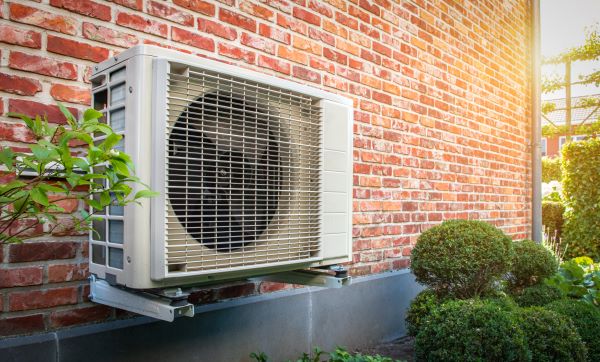On a cold day, nothing beats the feeling of stepping into a nice, toasty, heated building. Nothing, that is, except perhaps setting foot in an air-conditioned room when it’s blazing hot outside. As heating and cooling costs rise, the ongoing demand for more inexpensive—and more environmentally friendly—methods of indoor climate control has grown. The result has been the development of several popular new technologies, with one of the most notable being the heat pump.
What is a heat pump, though? How does it work? In what situations is it most practical? In this blog post, we’ll explain the benefits and drawbacks of this efficient method of heating and cooling your home.
Heat Pumps: A New Use for Tried-and-True Technology
Heat pumps get their name from the fact that, unlike traditional heating methods, they don’t require a fuel source to generate heat. Instead, they absorb ambient heat from the outdoor environment and pump it into the home. This bypasses the need for a large furnace or an air circulation unit.
While heat pumps are certainly considered to be a major advancement in heating technology, the scientific principle underpinning them is actually one that has already been in use for over a century. Just like a traditional air conditioner or a refrigerator, they utilize a super condensed coolant gas, which absorbs heat from the environment as it expands and is converted from a liquid into a gas. In a refrigerator, this can be used to remove heat energy to create a cooling effect. With a heat pump, the heat is instead drawn into the building, where it can be vented directly into a chosen area.
Not only does this eliminate the need for large equipment and expensive fuel, but it also allows the system to double as an air conditioner during warmer months. Simply switch the heat pump into cooling mode, and it will draw heat energy from the inside and vent it to the outside.
Parts of a Heat Pump
A heat pump consists of an outdoor element and an indoor element, which are connected by a series of refrigerant lines. These lines are used to transfer thermal energy. The outdoor unit contains the compressor coil, which pressurizes the coolant gas. When the gas is pressurized, it becomes cold. Supercooled gas under pressure heats up as it expands, drawing heat from the surrounding environment. The coolant gas is then pumped into the indoor element, where a condenser can then release the stored heat energy into the home. This process works in reverse when the device’s cooling function is used.
The heat pump is controlled by a thermostat. When you set the thermostat to your preferred temperature, it communicates with the heat pump, cycling it on and off as needed to achieve and maintain the temperature you desire.
How a Heat Pump Benefits Both the Environment and Your Wallet
There are several primary benefits that a heat pump has over other methods of heating the home. As we’ve mentioned, they do not require a fuel source or to create heat energy. Instead, they make use of heat that already exists in the environment. Eliminating the need to burn coal, oil, gas, and other fossil fuels dramatically reduces your carbon footprint and nets significant savings on energy costs over the course of the year.
Heat pumps provide more targeted heating and tend to be smaller than furnaces, so they can be used to heat specific areas of the home, as opposed to the entire building. By focusing only on areas that are occupied, heat pumps further cut down on energy costs.
The environmental benefits mean that many governments have now chosen to incentivize homeowners to install heat pumps. In many states, tax credits and energy rebates are available for those who choose to utilize this green technology for heating and cooling their buildings.
What Are the Different Types of Heat Pumps?
There are different types of heat pumps to choose from depending on a home’s specific needs. They can differ in the source of the heat energy they provide. Geothermal heat pumps draw heat from beneath the surface of the earth while air-source pumps draw it from the air.
Heat pumps also differ from each other in the methods they use to distribute heat energy. They can utilize traditional blower fans, but for users who wish to heat or cool smaller spaces or one that simply doesn’t have a system of ductwork, ductless or mini-split heat pumps are also available.
Are There Any Drawbacks?
Heat pumps do have certain limitations when compared to more traditional methods of heating and cooling. Because they utilize heat from the environment, they may struggle in extremely cold climates where there is very little ambient thermal energy to be found. If that’s the case, it may be necessary to supplement their use with a natural gas furnace or other fuel source. Typically, this will only be needed on the coldest days of the year.
Heat pumps also tend to be smaller and less powerful than other methods of heating or cooling. This means that you may need to opt to have several of them installed in a larger building, which can initially be prohibitively expensive for many homeowners. Note, however, that homeowners often consider their smaller size to be an advantage, as it allows them to be used in areas that would otherwise be unreachable by traditional heating technology, such as parts of the home without ductwork. In this way, heat pumps are very versatile.
If you have any questions about whether or not a heat pump is right for your home, or if you want to discuss having one installed, contact All Weather Heating & Cooling. Our experts will help you through every step of the process so that you can begin to take advantage of this revolutionary technology and the benefits that come with it.

